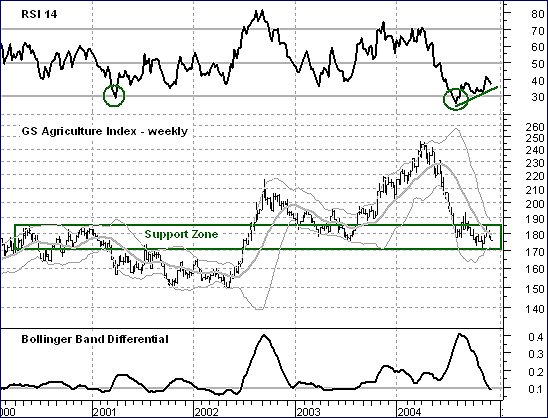
HOT TOPICS LIST
- MACD
- Fibonacci
- RSI
- Gann
- ADXR
- Stochastics
- Volume
- Triangles
- Futures
- Cycles
- Volatility
- ZIGZAG
- MESA
- Retracement
- Aroon
INDICATORS LIST
LIST OF TOPICS
PRINT THIS ARTICLE
by Arthur Hill
While most commodity groups remain in major uptrends, the GS Agriculture Index recorded a two-year low last month. However, the decline is slowing and support is at hand.
Position: Hold
Arthur Hill
Arthur Hill is currently editor of TDTrader.com, a website specializing in trading strategies, sector/industry specific breadth stats and overall technical analysis. He passed the Society of Technical Analysts (STA London) diploma exam with distinction is a Certified Financial Technician (CFTe). Prior to TD Trader, he was the Chief Technical Analyst for Stockcharts.com and the main contributor to the ChartSchool.
PRINT THIS ARTICLE
BOLLINGER BANDS
Descent Slowing In GS Agriculture Index
12/02/04 08:04:42 AMby Arthur Hill
While most commodity groups remain in major uptrends, the GS Agriculture Index recorded a two-year low last month. However, the decline is slowing and support is at hand.
Position: Hold
| The weekly price chart for the GS Agriculture Index ($GKX) shows a large support zone between 170 and 185 that extends back to May 2000. The index met resistance around 185 in May 2000 and then support around 175 in July 2003. The index moved back into this support zone in July 2004 and has been consolidating since above 170. |
| The relative strength index (RSI) shows that the index became oversold and that the decline is slowing as the indicator moved below 30 for the second time in five years. RSI moved below 30 in March 2001, but it still looks like another 12 months for the index to find a bottom. The decline simply slowed from March 2001 to March 2002. |

|
| Figure 1: GS Agriculture Index and the Bollinger Band Differential |
| Graphic provided by: MetaStock. |
| Graphic provided by: Reuters Data. |
| |
| RSI recorded a low below 30 in July 2004 and has managed to hold above this low so far. As such, a positive divergence has formed (the index went to new lows and RSI held above its prior low). At the very least, this suggests that the worst of the decline may be over. But when will the next move start? |
| Watch the Bollinger Bands for signs that a move may be starting. The width of the Bollinger Bands typically contracts prior to a significant move. The lower chart shows the difference between the upper and lower band. This shows up as a percentage of the middle band or 20-day exponential moving average (EMA). The Bollinger Band differential is now trading below 0.10, which is relatively low by historical standards. Look for a break above the upper band or below the lower band to signal the start and the direction of the next move. |
Arthur Hill is currently editor of TDTrader.com, a website specializing in trading strategies, sector/industry specific breadth stats and overall technical analysis. He passed the Society of Technical Analysts (STA London) diploma exam with distinction is a Certified Financial Technician (CFTe). Prior to TD Trader, he was the Chief Technical Analyst for Stockcharts.com and the main contributor to the ChartSchool.
| Title: | Editor |
| Company: | TDTrader.com |
| Address: | Willem Geetsstraat 17 |
| Mechelen, B2800 | |
| Phone # for sales: | 3215345465 |
| Website: | www.tdtrader.com |
| E-mail address: | arthurh@tdtrader.com |
Traders' Resource Links | |
| TDTrader.com has not added any product or service information to TRADERS' RESOURCE. | |
Click here for more information about our publications!
Comments
Date: 12/02/04Rank: 4Comment:

|

Request Information From Our Sponsors
- StockCharts.com, Inc.
- Candle Patterns
- Candlestick Charting Explained
- Intermarket Technical Analysis
- John Murphy on Chart Analysis
- John Murphy's Chart Pattern Recognition
- John Murphy's Market Message
- MurphyExplainsMarketAnalysis-Intermarket Analysis
- MurphyExplainsMarketAnalysis-Visual Analysis
- StockCharts.com
- Technical Analysis of the Financial Markets
- The Visual Investor
- VectorVest, Inc.
- Executive Premier Workshop
- One-Day Options Course
- OptionsPro
- Retirement Income Workshop
- Sure-Fire Trading Systems (VectorVest, Inc.)
- Trading as a Business Workshop
- VectorVest 7 EOD
- VectorVest 7 RealTime/IntraDay
- VectorVest AutoTester
- VectorVest Educational Services
- VectorVest OnLine
- VectorVest Options Analyzer
- VectorVest ProGraphics v6.0
- VectorVest ProTrader 7
- VectorVest RealTime Derby Tool
- VectorVest Simulator
- VectorVest Variator
- VectorVest Watchdog
